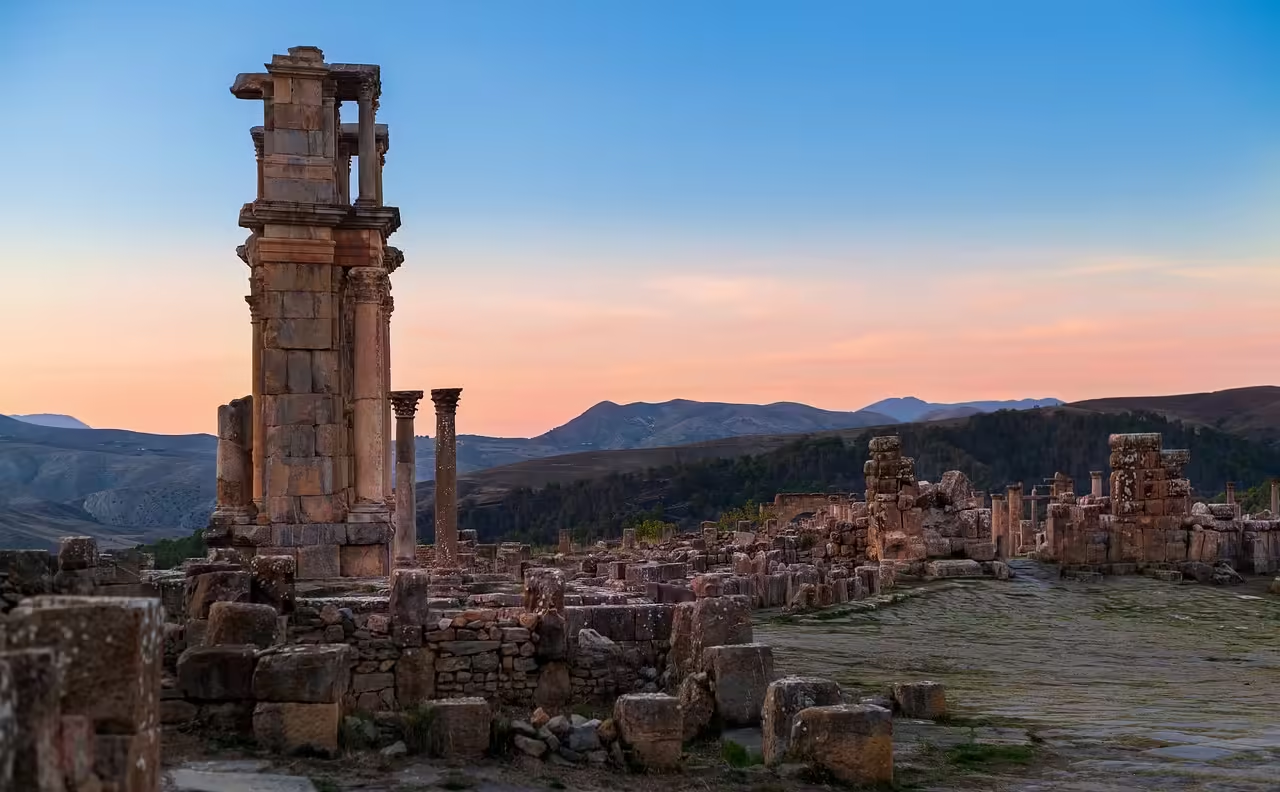Djemila in Algeria
Djemila in Algeria. Roman History Meets Mountain Beauty
Tucked away in the northeastern mountains of Algeria, Djemila offers one of North Africa’s most impressive archaeological experiences. This ancient Roman city, remarkably well-preserved and surrounded by stunning landscapes, invites visitors to explore its rich history, architectural brilliance, and cultural significance. For anyone passionate about ancient civilisations, Djemila in Algeria is a must-see destination.
A Roman City in the Mountains
Unlike many Roman cities built along coastlines, Djemila occupies a strategic mountain location. Originally named Cuicul, the city was founded in the first century AD under Emperor Nerva as a settlement for retired soldiers. Its elevated position allowed it to protect and connect key agricultural regions within the Roman Empire.
This unique setting influenced the city’s layout. Roman engineers adapted their designs to the rugged terrain, blending natural beauty with urban planning. The result is a city that feels both grand and intimate, with streets and buildings that follow the contours of the land.
Walking through Djemila today, visitors can appreciate how well the city has been preserved. Stone-paved roads, public squares, and residential areas remain intact, offering a rare opportunity to experience Roman life in its original form.
Architectural Highlights and Civic Life
At the heart of Djemila lies the central forum, a spacious plaza once used for trade, politics, and religious gatherings. Surrounded by columns and elegant structures, the forum reflects the Roman emphasis on civic engagement and community life.
One of the most striking buildings is the Capitolium, a temple dedicated to Jupiter, Juno, and Minerva. Its towering columns and detailed carvings showcase Roman craftsmanship and devotion. Nearby, the basilica served judicial and administrative functions, illustrating how religious and civic life were closely linked in Roman cities.
The Arch of Caracalla stands as a tribute to the emperor and his family. Its intricate carvings and commanding presence make it a popular spot for photography and reflection. This triumphal arch symbolises imperial pride and the city’s connection to broader Roman politics.
The Theatre and Its Natural Harmony
Djemila’s theatre is another architectural gem. Built into the hillside, it demonstrates how Roman architects worked with the landscape rather than against it. The natural slope provided excellent acoustics and seating for thousands of spectators.
This venue once hosted plays, speeches, and public events. Standing in the theatre today, visitors can imagine the applause and excitement that once filled the space. The design remains functional and beautiful, a testament to Roman ingenuity.
The theatre’s location also offers sweeping views of the surrounding countryside. This blend of cultural activity and natural scenery adds to the site’s appeal, making it a place for both learning and leisure.
Mosaics and Artistic Legacy
Djemila is renowned for its mosaics, many of which remain in their original locations. These artworks depict scenes from mythology, daily life, and nature, revealing the values and aesthetics of the time.
The mosaics add colour and detail to the stone city, bringing its history to life. They reflect the skill of Roman artisans and the cultural influences that shaped their work. Some of the finest examples are housed in the onsite museum, where visitors can view them up close and learn about their themes and techniques.
In addition to mosaics, the museum contains pottery, tools, and inscriptions that provide further insight into life in Djemila. These artefacts help build a fuller picture of the city’s social and economic structure.
A Peaceful Setting for Exploration
Surrounded by rolling hills and lush greenery, Djemila offers a tranquil atmosphere that enhances the visitor experience. The ruins stand in quiet contrast to the vibrant countryside, creating a space for reflection and discovery.
Unlike many crowded tourist destinations, Djemila remains peaceful. Visitors can explore at their own pace, taking time to absorb the site’s beauty and significance. The combination of historical depth and natural serenity makes Djemila in Algeria a truly rewarding place to visit.
Birdsong, gentle breezes, and the rustle of leaves contribute to the ambience. These sounds, along with the visual splendour of the ruins, create a multisensory experience that connects past and present.
Planning Your Visit
To make the most of your trip to Djemila, consider the following tips:
- Best Time to Visit: Spring and autumn offer mild weather and clear skies, ideal for walking and photography.
- Getting There: Djemila is located near the town of Sétif. Public transport is available, but hiring a car or joining a guided tour provides more flexibility.
- What to Bring: Comfortable shoes, sun protection, water, and a camera are essential. A notebook or sketchpad can also be useful for capturing impressions.
- Local Etiquette: Respect the site by staying on marked paths and avoiding contact with fragile structures. Engage with local guides to deepen your understanding.
- Accessibility: While some areas may be uneven, many parts of the site and museum are accessible to visitors with mobility needs.
A Gateway to the Ancient World
Visiting Djemila is more than a sightseeing trip, it’s an immersive journey into Roman history. The city’s ruins, artworks, and natural surroundings offer a unique blend of education, inspiration, and connection.
Djemila in Algeria stands out as one of the most authentic Roman sites outside Italy. Its preservation, location, and cultural richness make it a valuable part of global heritage. For travellers seeking meaningful experiences, Djemila delivers on every level.
Whether you’re drawn by history, architecture, or nature, this ancient city invites you to explore its stories and share in its legacy. The experience lingers long after you leave, encouraging reflection and a deeper appreciation for the past.

